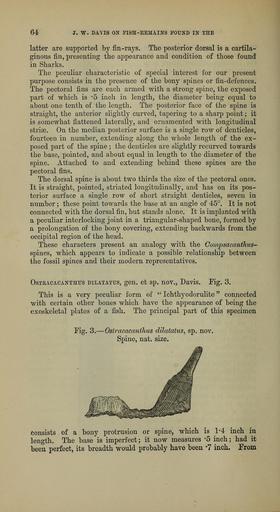MAKE A MEME
View Large Image

| View Original: | The_Quarterly_journal_of_the_Geological_Society_of_London_(12960426584).jpg (1750x3200) | |||
| Download: | Original | Medium | Small | Thumb |
| Courtesy of: | commons.wikimedia.org | More Like This | ||
| Keywords: The Quarterly journal of the Geological Society of London (12960426584).jpg 64 J W DATIS ON riSH-KEMAINS TOUND IN THE <br> latter are supported by fin-rays The posterior dorsal is a cartila- <br> ginous fin presenting the appearance and condition of those found <br> in Sharks <br> The peculiar characteristic of special interest for our present <br> purpose consists in the presence of the bony spines or fin-defences <br> The pectoral fins are each armed with a strong spine the exposed <br> part of which is -5 inch in length the diameter being equal to <br> about one tenth of the length The posterior face of the spine is <br> straight the anterior slightly curved tapering to a sharp point ; it <br> is somewhat flattened laterally and ornamented with longitudinal <br> striae On the median posterior surface is a single row of denticles <br> fourteen in number extendiug along the whole length of the ex- <br> posed part of the spine ; the denticles are slightly recurved towards <br> the base pointed and about equal in length to the diameter of the <br> spine Attached to and extending behind these spines are the <br> pectoral fins <br> The dorsal spine is about two thirds the size of the pectoral ones <br> It is straight pointed striated longitudinally and has on its pos- <br> terior surface a single row of short straight denticles seven in <br> number ; these point towards the base at an angle of 45° It is not <br> connected with the dorsal fin but stands alone It is implanted with <br> a peculiar interlocking joint in a triangular-shaped bone formed by <br> a prolongation of the bony covering extending backwards from the <br> occipital region of the head <br> These characters present an analogy with the Convpsacanthus- <br> spines which appears to indicate a possible relationship between <br> the fossil spines and their modern representatives <br> OsTEACACANTHUS DiLATATTJS geu ct sp nov Davis Pig 3 <br> This is a very peculiar form of Ichthyodorulite connected <br> with certain other bones which have the appearance of being the <br> exoskeletal plates of a fish The principal part of this specimen <br> Fig 3 ” Ostracacantlius dilatatus sp nov <br> Spine nat size <br> consists of a bony protrusion or spine which is 1 4 inch in <br> length The base is imperfect; it now measures -5 inch; had it <br> been perfect its breadth would probably have been -7 inch From 36090399 111264 51125 Page 64 Text 36 http //www biodiversitylibrary org/page/36090399 1880 Geological Society of London Biodiversity Heritage Library The Quarterly journal of the Geological Society of London v 36 1880 Geology Periodicals Smithsonian Libraries bhl page 36090399 dc identifier http //biodiversitylibrary org/page/36090399 smithsonian libraries Information field Flickr posted date ISOdate 2014-03-06 Check categories 2015 August 26 CC-BY-2 0 BioDivLibrary https //flickr com/photos/61021753 N02/12960426584 2015-08-26 16 53 12 cc-by-2 0 PD-old-70-1923 The Quarterly journal of the Geological Society of London 1880 Photos uploaded from Flickr by Fæ using a script | ||||